The Samsung 960 EVO (1TB) Review
by Billy Tallis on November 15, 2016 10:00 AM ESTMixed Random Read/Write Performance
The mixed random I/O benchmark starts with a pure read test and gradually increases the proportion of writes, finishing with pure writes. The queue depth is 3 for the entire test and each subtest lasts for 3 minutes, for a total test duration of 18 minutes. As with the pure random write test, this test is restricted to a 16GB span of the drive, which is empty save for the 16GB test file.
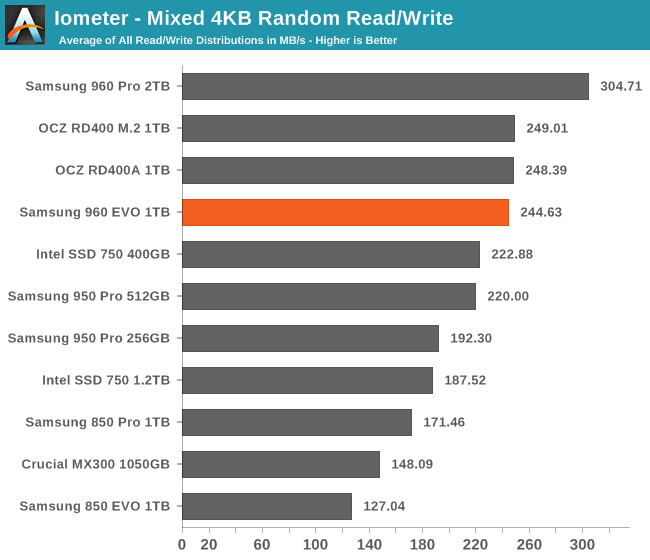
The 960 EVO is essentially tied for second place with the OCZ RD400 and significantly behind the 960 Pro in overall performance on mixed random I/O.
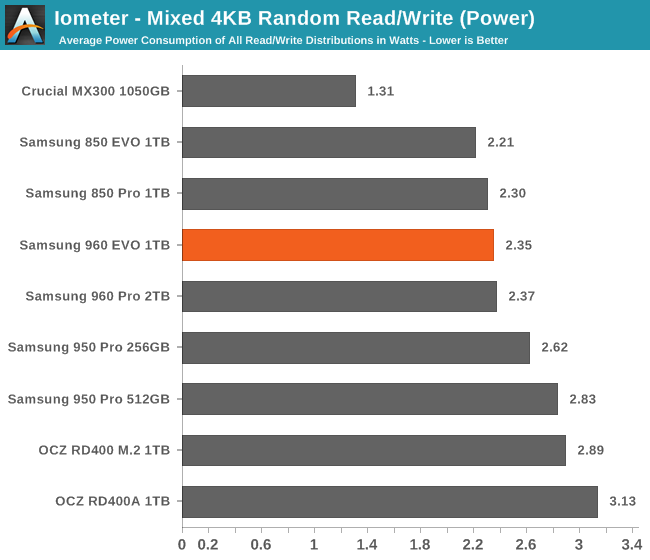
The 960 EVO's power efficiency on this test is not great, but it is a big improvement over last year's 950 Pro.
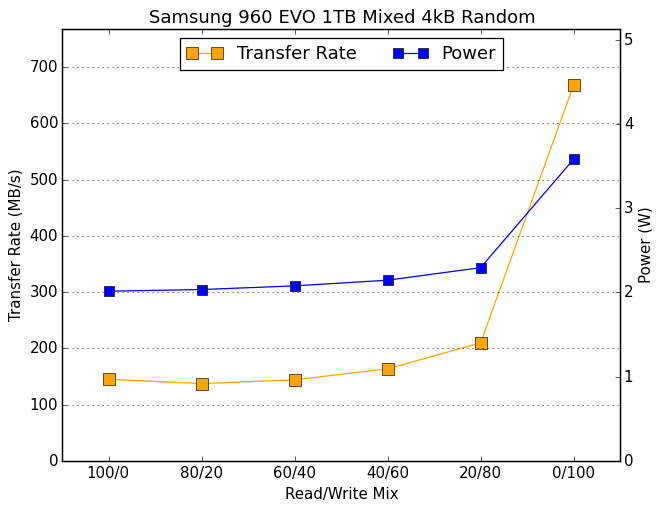 |
|||||||||
The 960 EVO's high performance score comes primarily from its great performance in the pure write final phase of the test. Throughout the rest of the test, the 960 EVO is not as fast as the 950 Pro.
Mixed Sequential Read/Write Performance
The mixed sequential access test covers the entire span of the drive and uses a queue depth of one. It starts with a pure read test and gradually increases the proportion of writes, finishing with pure writes. Each subtest lasts for 3 minutes, for a total test duration of 18 minutes. The drive is filled before the test starts.
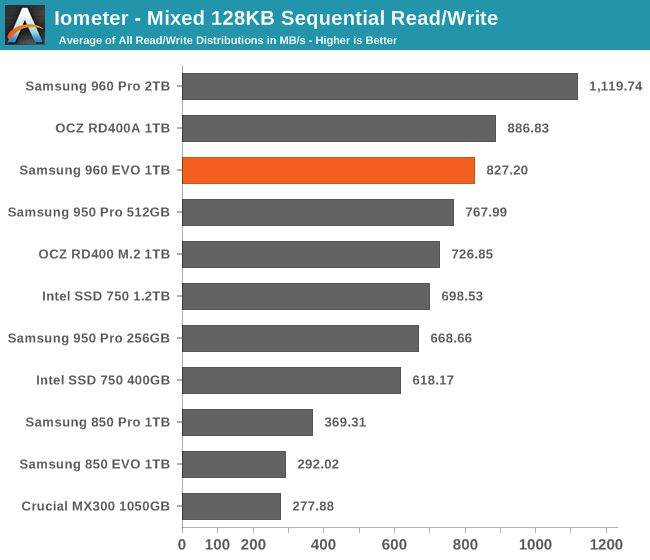
The 960 EVO's mixed sequential I/O performance is the second-fastest among M.2 SSDs and third place overall. Performance is modestly improved over the 950 Pro.
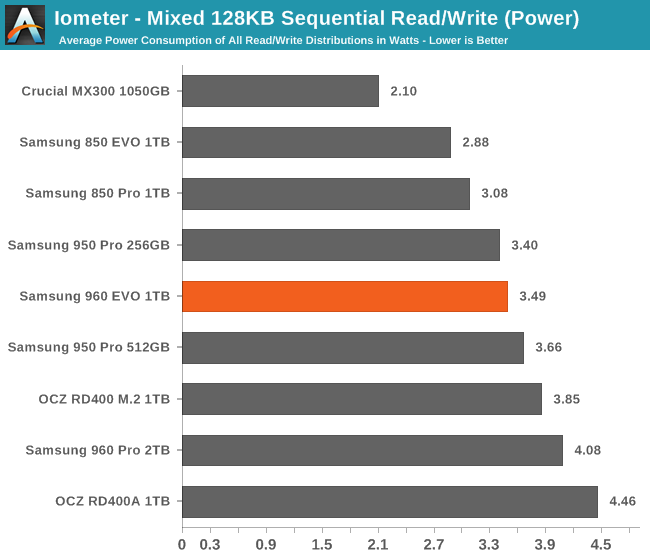
The 960 EVO's power efficiency is better than most PCIe SSDs, but still well behind the 960 Pro.
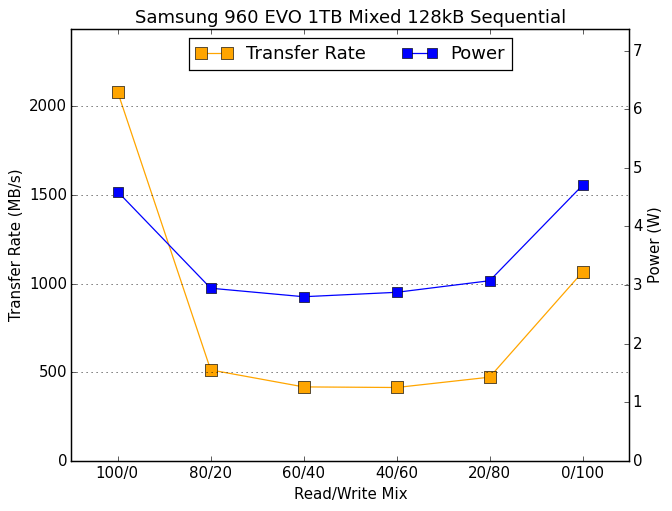 |
|||||||||
The 960 EVO's performance in the pure read first phase of the test is great, but its performance with an 80/20 mix is much worse than the 950 Pro or OCZ RD400. The worst-case performance is also not as good as the RD400 or 960 Pro.










87 Comments
View All Comments
TheinsanegamerN - Tuesday, November 15, 2016 - link
Is there currently any consumer software that can change these settings?Billy Tallis - Tuesday, November 15, 2016 - link
I use nvme-cli on Linux to manually test these settings, and there's a patch working its way toward a stable kernel release that will let supporting drives automatically make use of their various idle states. I'm not aware of any Windows tools that give the same degree of fine-grained control, but Intel's tools for enterprise SSDs and the 750 have some power management options.TheinsanegamerN - Tuesday, November 15, 2016 - link
That would be nice. I'd love to be able to set my 950 pro to a max of, say 2 watt on battery, or set the maximum speed to sata III speed (on battery), if it meant better battery life, and enable full speed when on mains power.philehidiot - Tuesday, November 15, 2016 - link
Yeh I noted the thermal limits kicking in and I did wonder if there's any major benefit from hacking these things, putting on some thermal goop, a big heat sink and a fan. Obviously it'll probably not help in the majority of cases but the mentalist part of me was pondering just how much performance there is to be unlocked.TheinsanegamerN - Tuesday, November 15, 2016 - link
The fan would be a bit of overkill, but the 950 pro showed some gains with a passive heatsink installed. The 960 would probably benefit even more.philehidiot - Tuesday, November 22, 2016 - link
Time to break out the liquid nitrogen. If anyone at work asks where it has all gone I'll just say I was remove the mother of all warts from a patient.philehidiot - Tuesday, November 22, 2016 - link
*removing. Bloody spelling.nagi603 - Tuesday, November 15, 2016 - link
A shame they dropped the write endurance to half of the 950!TheinsanegamerN - Tuesday, November 15, 2016 - link
TLC vs MLCbull2760 - Tuesday, November 15, 2016 - link
Why do you not show consistent results. In some tests you include the Intel 750 and on other you exclude it in the graph. You excluded the Intel 750 in the power consumption both times. Are you not able to calculate the power being used when the Intel drive is being used?